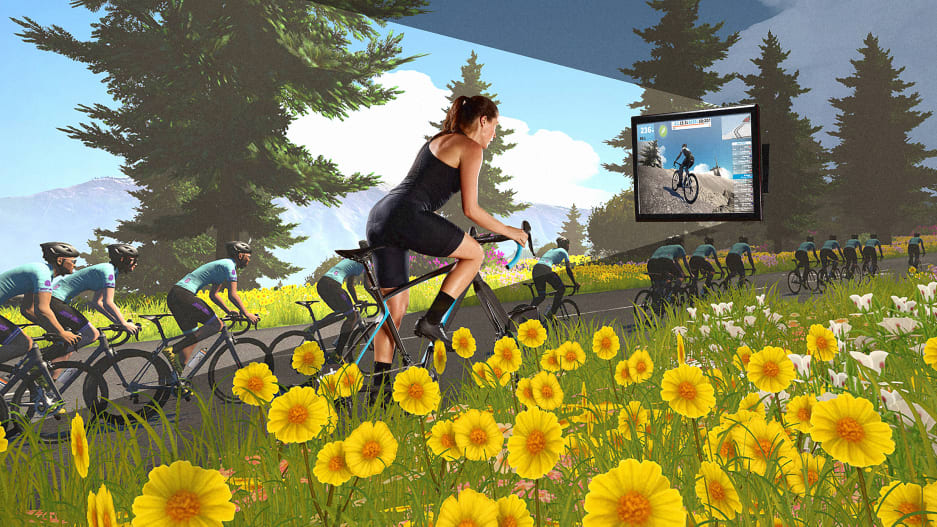[Images: ASO, Wahoo]
BY MARK WILSON
Source: www.fastcompany.com, June 2020
Zwift, a platform for racing bikes from the comfort of your home, has taken off amid the coronavirus pandemic and is even powering this year’s virtual Tour de France. Next stop? The Olympics.
A friend wants to go for a ride. He has been cycling forever, and I’ve taken the last 20 years off, so he chooses the trail—a 2,000-foot climb up a small mountain. Moments after agreeing, I realize this is a terrible mistake.
The perfectly cheery, flat path gives way to the hill. My bike’s front tire rears up. My legs, which were impossibly strong seconds ago, feel like they’re pedaling a World War I-era steel tank instead of a carbon-framed Cannondale Topstone.
With every stroke of the pedal, I’m sure I’ll give up at the next. Ten minutes pass. Then 20. That’s not long in cycling terms, but tell that to my legs, which are burning so badly they might spontaneously combust. The only consolation is a sudden breeze that strikes my body, wicking sweat away.
So focused on my own pain, I barely notice that my friend has started to lag behind. Then, he disappears. I get a text that he’s trying another route.
I guess some people just can’t hang. Even in a video game.
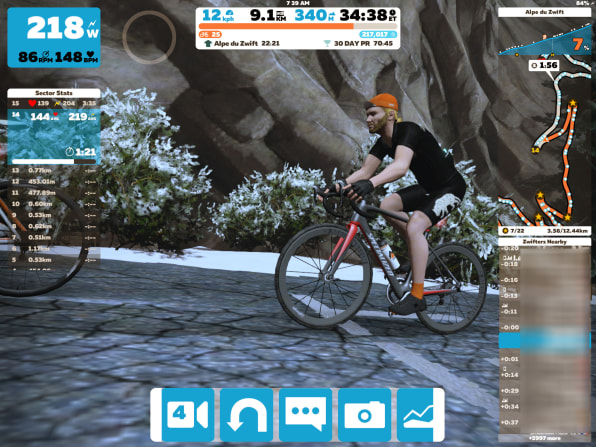
This whole experience played out on an app called Zwift that runs on my laptop. The app is digital, but the experience of racing online is extremely physical, thanks to a suite of high-tech accessories, from the company Wahoo, that are built to measure my performance while simulating a real ride. I sit on a real bike with both wheels removed. Where the front tire would go is a Wahoo Climb, which lifts my frame up and down like a mechanical bull to simulate hills. The back tire is replaced with a Wahoo Kickr, a “trainer” that loops my chain onto a weighted wheel to convincingly simulate various degrees of resistance. Meanwhile, a heart rate monitor on my arm connects to a fan called the Headwind, which blows air based upon my simulated speed. How can I see my laptop from my bike? There’s a solution for that, too, with a rubber-topped telescoping desk that floats right over my handlebars. All in all, it’s about $5,000 in racing equipment that’s guaranteed to never move me an inch, the finest hamster wheel that money can buy.
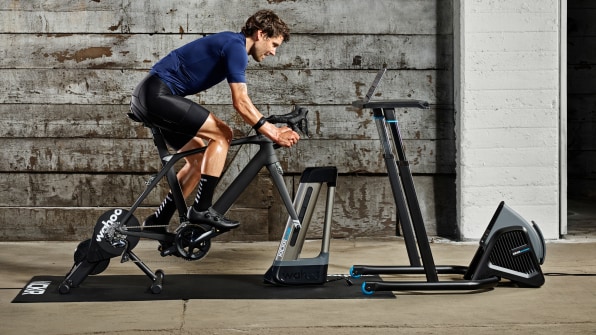
And it’s immensely popular right now. In the COVID-19 era, as quarantine has forced both casual and professional cyclists to train at home. Usage of Zwift, which was founded in 2014, doubled between January and April. Then the company scored a bigger coup: Dozens of the world’s fastest cyclists will be competing in a virtual Tour de France hosted on Zwift, beginning July 4, dubbed The Tour Virtuel, with the sport broadcast live on TV. (The traditional Tour de France is now slated to begin at the end of August.) Ironman, which includes cycling, running, and swimming components, has also partnered with a Zwift competitor, Rouvy, on virtual races for its triathletes. In-real-life sports are making the jump to the digital world.
Will it last after quarantines end? Zwift is betting on it. Pro sports are already $70 billion industry. Esports were only a $951 million industry in 2019—but they’re growing. Zwift’s CEO Eric Min sees room for traditional sports to augment the existing esports model, which is dominated by gamers at desks, with more conventional athletic prowess. He even thinks virtual cycling has a place at the biggest competitive sporting event in the world. “We would be the first athletic digitized sport ever to enter into formal disciplines of traditional sports,” Min says. “That’s our fastest path to get into the Olympics.”
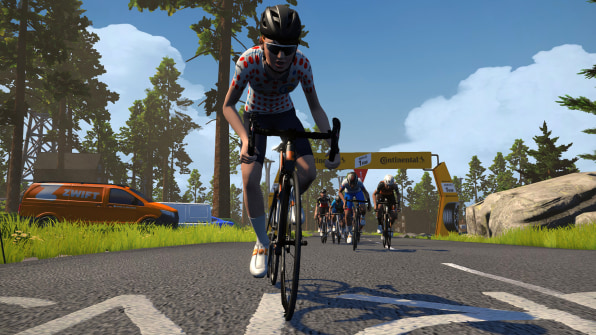
THE SURGE IN CYCLING
Viewership of any professional sport relies on accessibility—for everyday Joes to play themselves, if only to appreciate how amazing it is every time LeBron James dunks. And amateur cycling has ballooned in 2020.
It began with a particularly mild winter. In the U.S., Cycling Sports Group, the parent company of Cannondale and GT, saw more people visiting bike shops and buying bikes in January and February than usual. “Every year, the bike industry waits with bated breath for spring, if it comes too late it can really impact sales,” says Nick Hage, North American general manager at Cycling Sports Group. “This year it came early.”
As COVID-19 began to spread through the United States, most bike shops shut down at the tail end of March. Sales essentially stopped for two weeks. Then bike shops were deemed essential businesses by the federal government. “Immediately in April, retailers started to see a boom,” Hage says. “As kids were home from school, even though they were doing remote learning, no one was playing sports . . . [so] cycling became a go-to activity for a lot of families.”
Bike sales grew 108% at big-box stores like Walmart, 125% at bike shops, and over 200% at Amazon, according to data provided to Fast Company by Pacific Cycle (which oversees brands including Schwinn and Mongoose). The spike happened so quickly that manufacturers weren’t able to replenish their stock. To this day, it’s difficult to find the bike you want, especially if it’s under $1,000.
As Hage explains, cycling sales fall into three sectors, which split the industry’s revenue into fairly equal thirds: families, commuters, and your off-road riding and Tour de France wannabe “enthusiasts.” These enthusiasts are the prosumers of the cycling world, and the key market for immersive simulation.
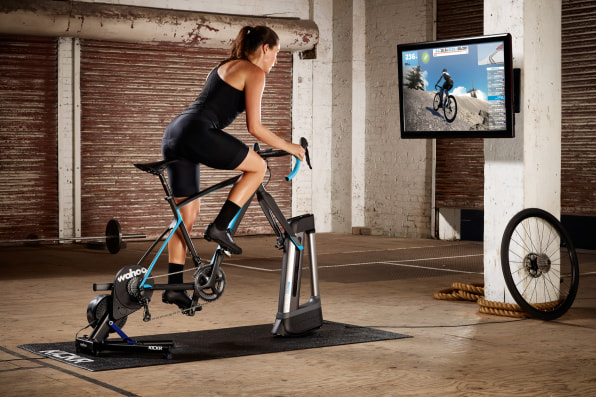
Wahoo is the leading provider of these bike simulation systems—the hardware complement to Zwift’s digital platform—which provided the gear I tested. Wahoo saw its own surge begin in February. “All of the sudden in Italy, in particular, our distributor was trying to order every trainer we could sell him,” says Mike Saturnia, CEO of Wahoo. Cycling is a bigger part of the culture in Europe than the U.S., and Wahoo saw sales spike in Italy and Spain, as people were worried lockdowns would prevent them from riding outdoors. By mid-March, you could not find a Wahoo trainer anywhere. Peloton, a company geared more toward people looking for exercise than cycling enthusiasts, experienced a similar surge, growing 30% over the course of a quarter.
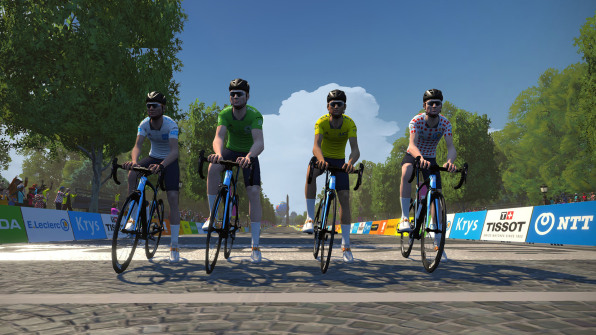
ZWIFT IS A RACING PLATFORM, BUT ALSO A SOCIAL NETWORK
As Zwift saw business rise in early 2020, the company realized the real appeal of its platform: virtual density—the sensation of thousands of people riding around you all the time. To log on to Zwift is to join another reality full of 24/7 races. Imagine the world of Disney Cars, but for bikes. You plop right on a road, and people begin passing you immediately as you get up to speed. You are already behind, but you are not alone. Each element of the experience coaxes you to go faster and faster. Catch up to a person who whizzes by, and you get XP to level up your rider (which equates to new outfits and bikes).
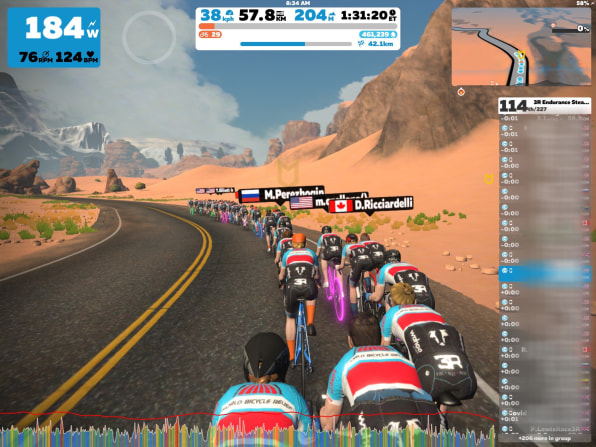
During COVID-19, the Zwift team realized that it wasn’t just the promise of a workout, or the thrill of competition, but the social experience that was bringing people online. Habitual cyclists, unable to ride together in real life, began meeting up virtually on Zwift, with these privately organized rides jumping 10 times between January and spring. This surge occurred even as Zwift pulled all online advertising, expecting its annual seasonal drop as the weather warmed and riders went back outside.
“That’s when we realized, we’re really a social network,” Min says. “People are looking for new ways of connecting, and we had the right solution for them.” Zwift quickly began churning out updates to support more socially connected riding—which expanded private groups to support up to 100 riders, along with some simple creature comforts, like ensuring you never take a wrong turn when riding with a friend.
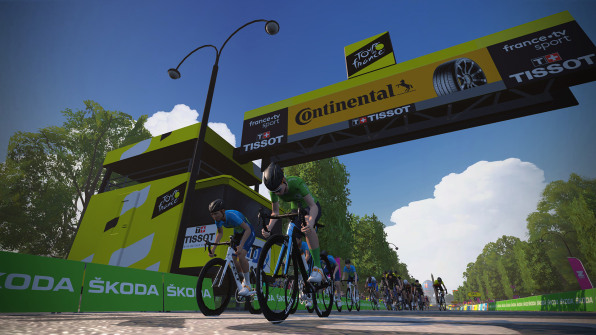
AN ACCELERATED TIMELINE
Now Zwift wants to take it to the next level and become the go-to platform for professional online cycling, and it’s starting at the top: Zwift is the official platform for the inaugural virtual Tour de France.
Zwift and the Amaury Sport Organization (ASO), which is the group that runs the Tour, have been in touch for years. As Julien Goupil, media director at ASO explains, the Tour is interested in the possibilities of digital platforms; it’s why they’ve embraced features like fantasy leagues to get casual fans more engaged.
But when the ASO realized the Tour could not run in July, they still felt like they needed to do something for the billion viewers around the world who would miss the event. So in late April, they decided to partner with Zwift on a virtual race—and ASO leveraged its might, enlisting 20 Tour broadcasters across the globe to announce the race as it aired internationally.

We’ve already seen video games, like League of Legends and Fortnite, become massively followed competitive events, each with over a hundred million players worldwide. And the past few months has given us a sneak peak of esports being played by real athletes, as ESPN televised NBA players playing each other in the popular NBA 2K video game. But real, digitized, athletic competition, broadcast on television, is an entirely new mashup, and it’s uncertain the world will embrace it.
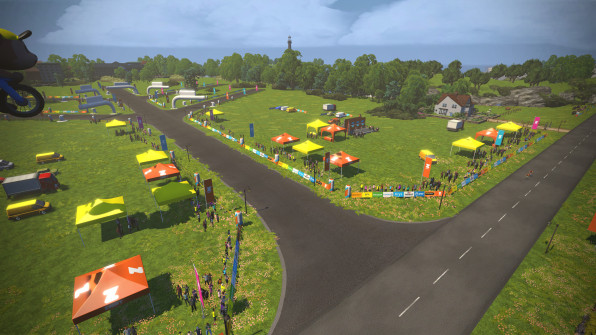
The questions lingering in the air now, especially as summer has pulled many of its riders back outside, are: Can Zwift be more than a social network for exercise? Can a real sport make the transition to an esport? And does that entire premise even make any sense?
ASO’s positioning of the Tour de France has been careful. Rather than duplicating the actual, full tour online, the race is being positioned as a best hits charity event. Over the course of three weekends, six one-hour races will take place for teams of men and women rather than individuals. It will begin in Watopia, a fictional, volcanic fantasy race course in Zwift. The race will also include new courses inspired by real Tour stops, such as Nice and Paris, France. Broadcast in 130 countries around the world, the race will end dramatically, through Paris’s Arc de Triomphe. “I’m not saying it will be the same if you win the virtual Tour as the real Tour,” says Goupil. “But I think it will create some noise on social networks, and there will be some competition.”
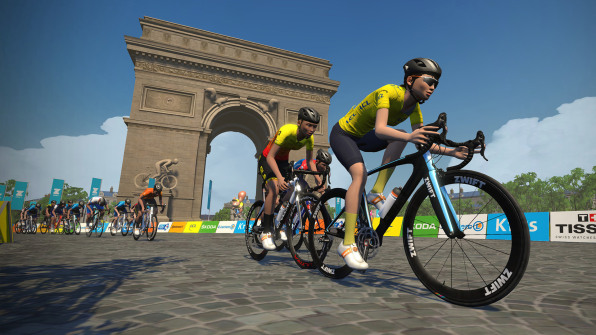
“A COMPLETELY DIFFERENT SPORT”
There are plenty of skeptics of the virtual format racing. “I think it’s a completely different sport,” says Simon Clarke, member of the Education First racing team (who will not partake in the virtual tour). “It’s like there’s track cycling, road cycling, and virtual cycling.”
Much like his teammate Sep Vanmarcke, whom I also talked to for this story, Clarke has a love-hate relationship with what riders dub “the rollers”—or riding on a trainer. It’s a safe, efficient way to practice, especially in wet weather or winter. It can be fun to interact with fans on the platform, too. But the digitization of cycling is an imperfect simulation.
Namely, you don’t need to balance or even turn, so cycling becomes a pure power sport, as if the only necessity to win a 2,200-mile race over mountains and cobblestones is fitness. And then there are far more complex strategies, like drafting behind other riders in a peloton, that are lost in a virtual world.
“There’s so much technique to that. How close you stick to someone, who you are behind—a little guy or big guy—how close to the front. There are so little things . . . discounted on a virtual platform,” Clarke says. “At 50 mph on an open road, you basically don’t have to pedal. Your exertion is 20% to 30% of the guy on the front. And that’s not the case on Zwift.”
But the virtual format does introduce some unique competitive challenges, unique to Zwift. Clarke points out that passing someone takes a lot more effort on Zwift than in real life. Put in a little less effort than the necessary passing threshold, and you get stuck in their wake. So if you choose to pass, you have to pedal harder and invest energy in that move.
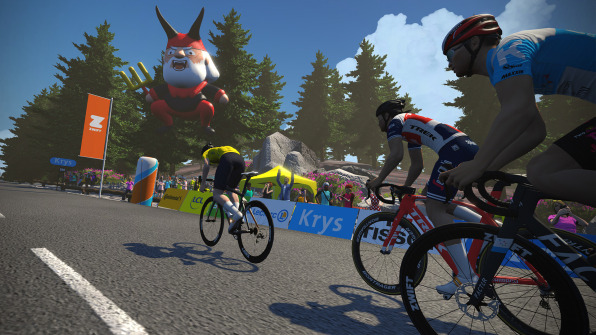
“At the end of the day, you’re pedaling against a computer, not against physics. If you understand how that computer is programmed that you’re pedaling against, of course it’s going to be more advantageous,” says Clarke. “The programmer who wrote the code for Zwift is probably the best Zwifter out there!”
There’s also the issue of cheating. (Yes, you can cheat in Zwift.) The most significant one is called “weight doping.” Zwift calculates your speed based upon your strength to weight ratio, and so by shaving a few pounds off of your claimed weight, you can add a lot more speed to your virtual ride.
For pros, perhaps this can be regulated, forcing weigh-ins with officials on the ground. But it’s a tricky fix to scale globally, and especially upsetting to enthusiasts who take online racing seriously.
Min, Zwift’s CEO, says that company is investing in more of its own hardware, rather than relying solely on partners like Wahoo, to make the racing more standardized. Zwift is also working on remote performance verification, and he sees it as absolutely essential to scale Zwift at the pro level. They’re currently partnered on a project with Amazon to build what he calls a “performance verification tool set.” It’s basically a highly trained, learning AI that can track your biomechanics over time to spot anomalies. “We’ll look at your historical data, and we will catch you,” says Min. “There are things like heart rate, how much power, how fast you can pedal . . . and there are limitations of the human body. There’s enough there that you can make almost a fingerprint. Eventually, we’ll know based upon your data who you are.”
With these technical challenges overcome, Min sees no limits for the Zwift platform. While it currently supports cycling and running, he imagines that rowing and other sports could translate well to Zwift, too. “What we learned about esports and why they’re so popular is that the viewers and players can experience the same game,” Min says. “You and I could never do the Tour de France, but if we made it available virtually, we could. We’d be slower than the top professionals! But we’d have the same experience between the fans and athletes . . . a connection between participating and viewing.”
Min’s next goal is nothing short of the Olympics. He’s been in discussions with the IOC to introduce Zwift racing as an exhibition in 2024, in hopes of making it a real Olympic event in the near future. “Guess where the 2028 Olympics is? In our backyard, in L.A.,” says Min. “That’s the journey we’re on.”

